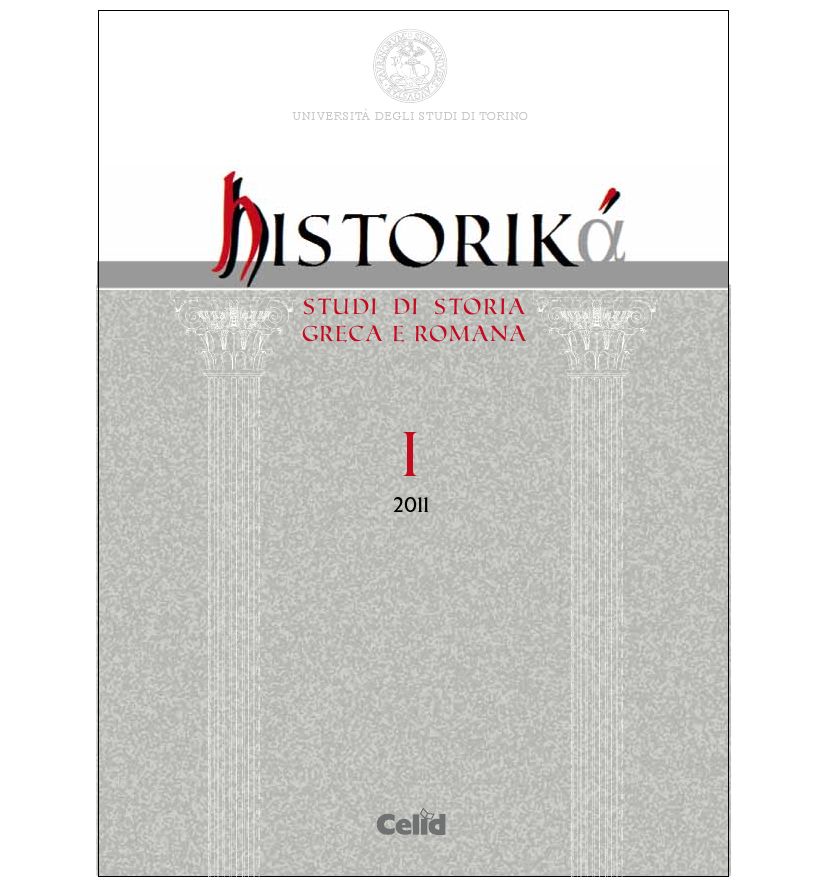The Direct Participation of Xenophon in the Narrated Events and His Historiographic Evaluation. Hellenica III-IV, 1: the Continued and Overturned Anabasis
DOI:
https://doi.org/10.13135/2039-4985/82Abstract
On a first reading of the Hellenica, the typical discontinuity of the narration about the scenery of the described events immediately strikes us. Athens, Asia and the Peloponnese follow one another, leaving the impression of a failure of understanding the simultaneity of the events in different places; on the contrary, the reader is led by the director-historiographer, who looks now here now there with his camera. But, which is the criterion that guides this selection? Trying to answer this question, I follow the interpretative way which links the narrative choices of Xenophon with the direct presence of the historiographer in the places where the narrated events occur. In particular I concentrate on books III-V of the Hellenika: I suggest a reading aimed to underline the connection of these books with the Anabasis in a new perspective. In this perspective, I bring out the relation between the central part of the Hellenika and the Anabasis; thus I show the reasons which bring Xenophon to a need that cannot be given up: the turn over of the Anabasis point of view and the suggestion of an inverted narration of the Asiatic events. In this way the author begins book III ascribing the fatherhood of the Anabasis to a third person and goes on showing not only a detailed knowledge, but also a specific care to keep the narration away from himself and his presence in Asia: Xenophon thus shows himself to be aware that only the separation of the narration from the attestation of one’s direct participation to the facts can make the work to be received as objective, authentically historical and not autobiographical. Because of it the protagonist of the Anabasis has to deny to be at the same time the author, while the author of the Hellenika asserts his role, hiding his direct presence in the narrated events.
Anche soltanto a una prima lettura, ciò che subito colpisce delle Elleniche è la discontinuità che caratterizza la narrazione a proposito dello scenario degli eventi descritti: Atene, l’Asia e il Peloponneso si succedono lasciando la sensazione che sia assente una comprensione degli eventi nella loro simultaneità in luoghi diversi. Al contrario, il lettore è in realtà condotto dal registra-storiografo che con la sua telecamera guarda ora a un luogo ora a un altro. Ma quale criterio conduce questa scelta?
Nel tentativo di dare una risposta a questa domanda percorro la via interpretativa che connette le scelte narrative di Senofonte alla presenza diretta dello storico nei luoghi di cui si narrano gli eventi. In particolare mi concentro sui libri III-V delle Elleniche: di questi propongo una lettura tesa a evidenziarne la connessione con l’Anabasi in una nuova prospettiva.
In questa prospettiva valorizzo dunque il rapporto tra il nucleo centrale delle Elleniche e l’Anabasi; mostro così le motivazioni che hanno portato Senofonte all’esigenza irrinunciabile di ribaltare il punto di vista dell’Anabasi e di proporre una narrazione rovesciata delle vicende d’Asia. In questo modo l’autore inizia il III libro attribuendo a terzi la paternità dell’Anabasi e prosegue mostrando non solo conoscenze dettagliate, ma anche specifica attenzione a tenere la narrazione lontana da sé e dalla propria presenza in Asia: Senofonte si mostra così consapevole che soltanto separando la narrazione stessa dall’attestazione della propria partecipazione diretta ai fatti può far sì che la propria opera sia recepita come obiettiva, autenticamente storica e non autobiografica. Per questo il protagonista dell’Anabasi deve negare di essere allo stesso tempo anche l’autore di quel racconto storico, mentre l’autore delle Elleniche afferma il proprio ruolo di storiografo celando la propria presenza diretta a una parte rilevante dei fatti narrati.
##submission.downloads##
Pubblicato
Fascicolo
Sezione
Licenza
Gli autori che pubblicano su questa rivista accettano le seguenti condizioni:
- Gli autori mantengono i diritti sulla loro opera e cedono alla rivista il diritto di prima pubblicazione dell'opera, contemporaneamente licenziata sotto una Licenza Creative Commons - Attribuzione che permette ad altri di condividere l'opera indicando la paternità intellettuale e la prima pubblicazione su questa rivista.
- Gli autori possono aderire ad altri accordi di licenza non esclusiva per la distribuzione della versione dell'opera pubblicata (es. depositarla in un archivio istituzionale o pubblicarla in una monografia), a patto di indicare che la prima pubblicazione è avvenuta su questa rivista.


 The journal has been approved for inclusion in DOAJ. The DOAJ listing of the journal is available at
The journal has been approved for inclusion in DOAJ. The DOAJ listing of the journal is available at 
